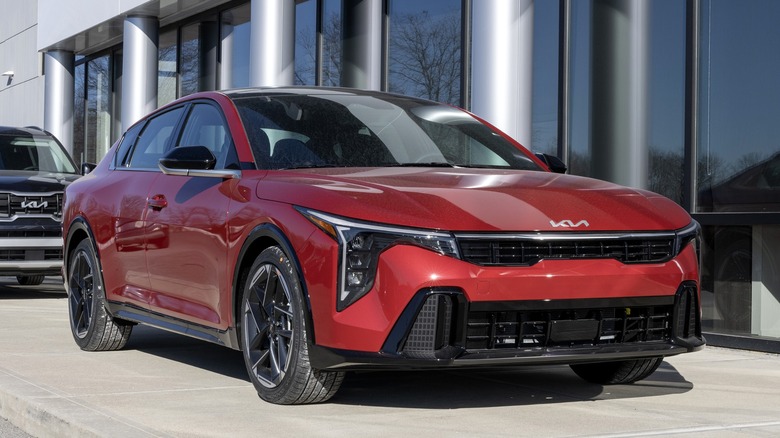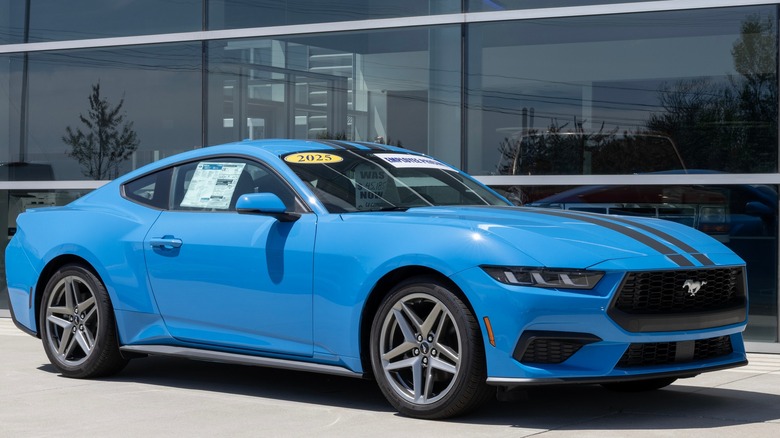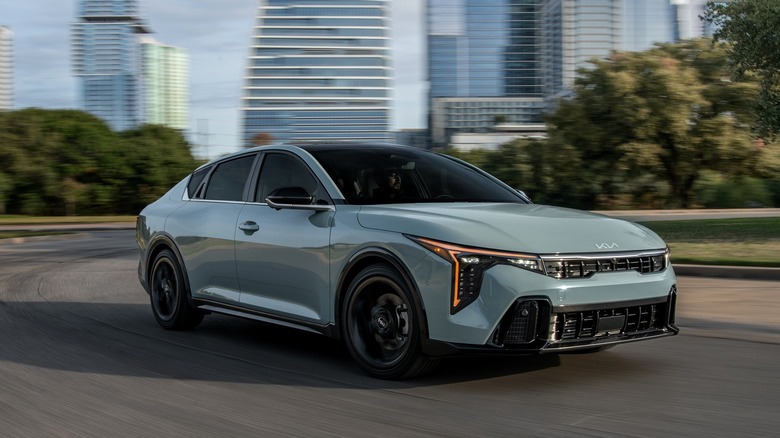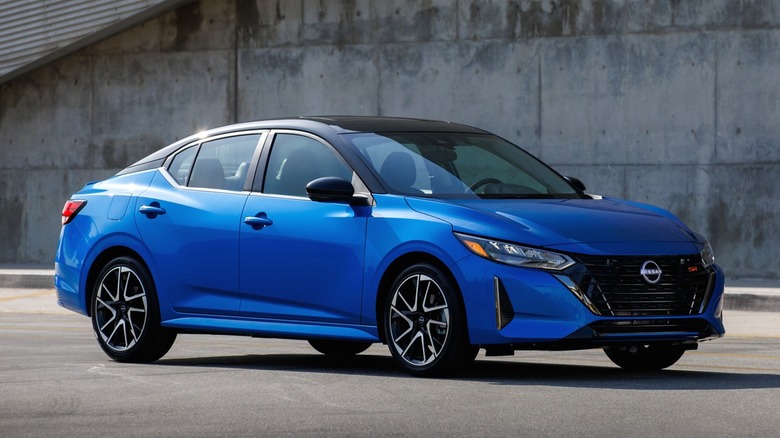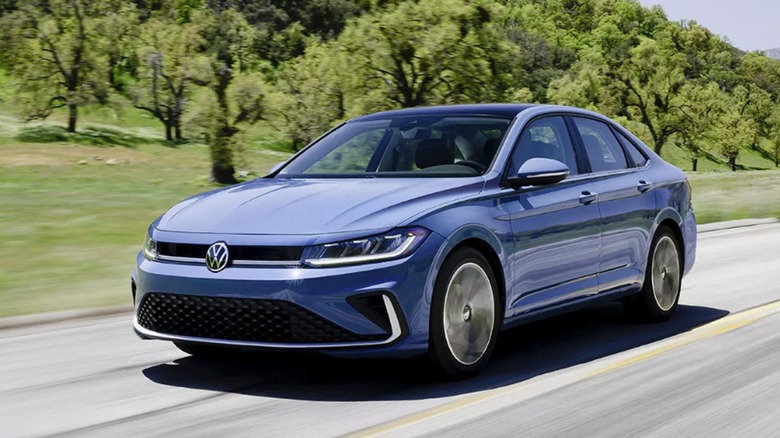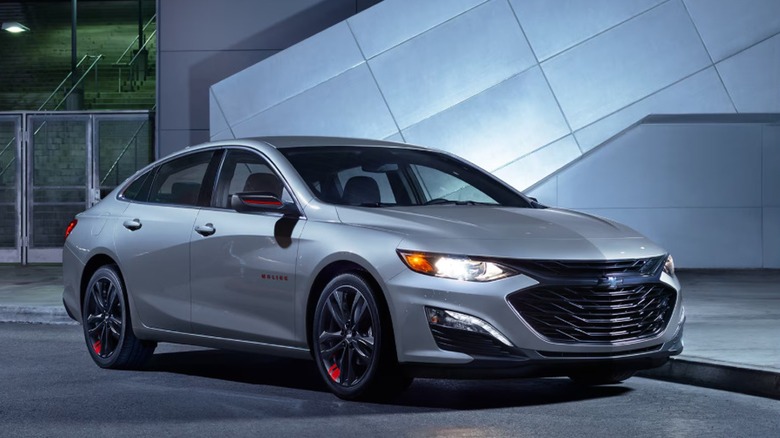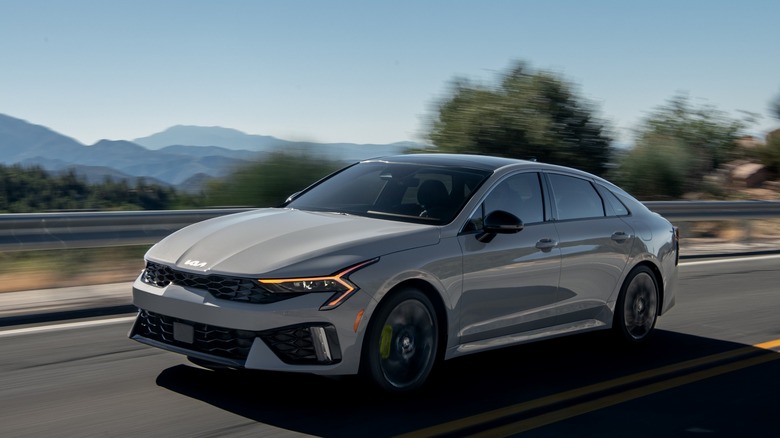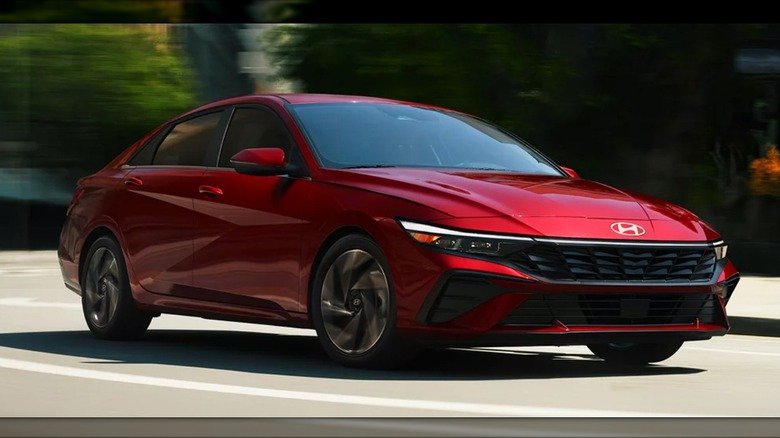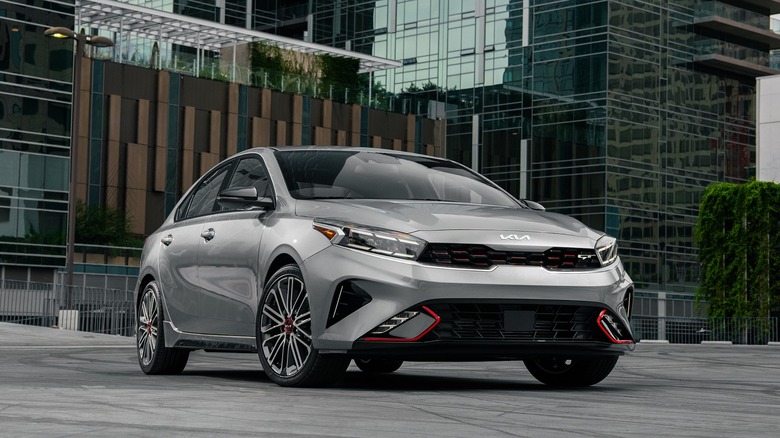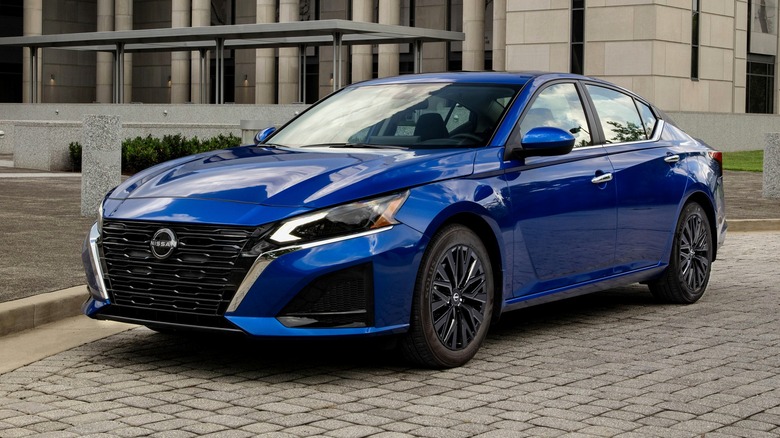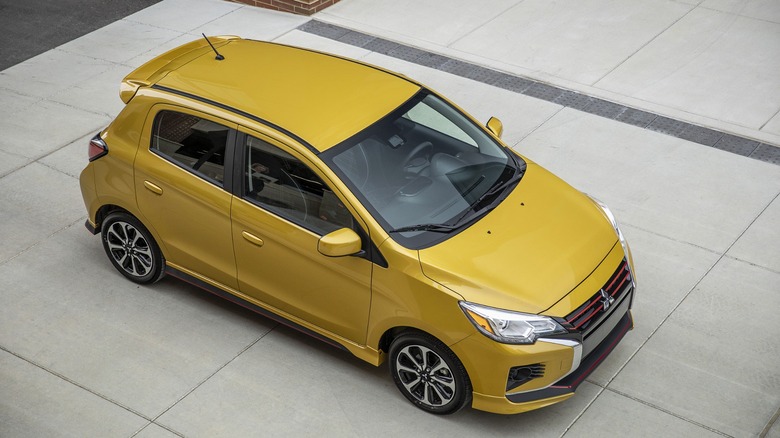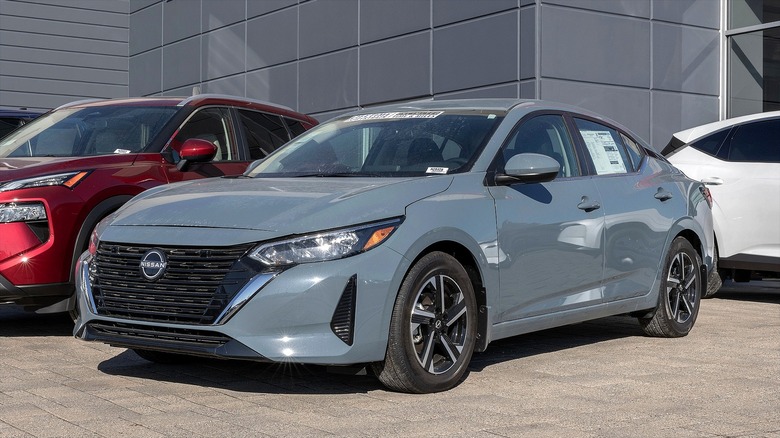10 New Cars With The Worst Safety Ratings
Just because a car is brand new doesn't mean it's any safer. Automakers love to lead with sleek designs and next-gen tech, so it's easy to think safety naturally comes with the package. But that's not always the case. Some new models still fall short — sometimes badly. Weak crash protection, poor structural integrity, or the absence of key safety features still show up, even among well-known brands.
That's why safety testing from the Insurance Institute for Highway Safety (IIHS) and the National Highway Traffic Safety Administration (NHTSA) matters so much. These agencies run cars through demanding crash tests covering everything from frontal and side impacts to rollover risks. The NHTSA hands out ratings using a five-star system, with five being its best. IIHS, on the other hand, rates using words: "Poor," "Marginal," "Acceptable," and "Good" across multiple safety categories. Learning how these systems work is actually helpful. They can help you reveal which cars can truly hold up when it matters.
For this list, we looked at new models that are available for sale that didn't perform well in safety testing. If a model received "Poor" or "Marginal" ratings in IIHS's critical areas like small overlap front collisions, side impact strength, or basic safety equipment, it's here. Some flopped in more than one test. So if safety is high on your list, these are the ones that fell short in safety ratings.
2025 Ford Mustang Coupe
First on the list is the 2025 Ford Mustang Coupe. The Mustang has always been about performance, style, and attitude, and the 2025 model keeps that tradition alive. It brings sharper looks, a more digital cabin, and engine options that still pack a punch. Whether you're in the turbo four-cylinder or the V8, it's built to thrill. But beneath all that performance, safety isn't exactly its strong suit.
It got a five-star overall rating from NHTSA, but even so, there are still weak spots in the details. Rear side-impact protection drops to four stars, and rollover risk comes in at 7.9%. Over at IIHS, the Mustang earned a "Marginal" rating in the structure and safety cage category. That means weaker lower body protection and clear signs of structural strain. Backseat child seats aren't much better off; LATCH access was rated "Marginal."
Yes, it comes with forward collision warning and crash-imminent braking, but the rest of the tech — like lane keeping and adaptive cruise — is often left off unless you pay for it. For a car that appeals to younger, performance-focused drivers, that's a gap worth noting.
2025 Kia K4
Next, the 2025 Kia K4. This marks a new chapter for Kia's compact sedan lineup as it steps in to replace the long-running Kia Forte. The design is more aggressive, the interior gets a major tech upgrade, and there's more space than you'd expect — especially in the back seat. On the surface, it has everything a modern car shopper will look for: a bold digital interface, enhanced safety features, advanced cruise control with full stop-and-go functionality, and a price that stays competitive. But you know, first impressions don't tell the whole story.
Old test results exposed a clear weak spot — especially in rear passenger protection. Despite a five-star overall rating from NHTSA, the K4 earned a "Poor" score in the updated IIHS moderate overlap front test for models built before February 2025. Dummy movement was uncontrolled, restraints couldn't manage impact forces, and chest injury risk was marked as "Marginal." Headlights, seat belt reminders, and LATCH anchors were all rated "Acceptable." The 9.9% rollover risk was of no help, either. The K4 is not a total collapse, but for a brand-new redesign, its crash performance falls short of expectations.
2025 Nissan Sentra
The 2025 Nissan Sentra feels like it's doing everything right at first, coming in with key safety tech like forward collision warning, lane departure alert, blind-spot detection, and crash imminent braking. That should be why NHTSA scores it five stars for overall rating, even though it dropped the ball to a four-star rating in the frontal crash for passengers. But when the IIHS reviewed it after giving it solid marks in the older tests, the cracks were revealed.
In the updated moderate overlap front test, the Sentra dropped to a "Marginal" rating. Rear-seat safety took the hit. The restraints didn't hold up, and dummy movement showed clear risk for head and chest injury. The side-impact test came in at "Acceptable," not great, for a car that should be improving. Pedestrian crash prevention slipped to marginal, too, especially in low-light conditions. Add a poor headlight rating and a 9.9% rollover risk, and it becomes harder to defend. However, it's important to note that a recent recall affected 199 Sentras (2025 model) due to an issue with manually adjustable driver's seats not being fully secured to the outboard seat track, which only adds to the growing list of concerns.
The Sentra is still a dependable daily driver, no doubt. In fact, we even have it down as one of Nissan's most reliable models. But in a segment where many competitors are refining protection across every seat and every crash angle, the Sentra feels a step behind.
2025 Volkswagen Jetta
The Jetta has always been Volkswagen's quiet achiever — strong, practical, and for years, one of the most reliable in the brand's history. The 2025 model keeps that reputation going by coming in with a mild refresh, including a more elegant exterior and a few tech tweaks inside — nothing major. It still runs the familiar 1.5-liter turbo engine and now includes VW's IQ.DRIVE suite as standard, which bundles lane keeping, automatic emergency braking, and forward collision warning. The NHTSA even backs it with a five-star rating. But when you look closer, some red flags appear, especially with the frontal crash ratings sliding to four stars, both for the driver and front passenger.
The IIHS flagged the seat belt reminders as "Poor," and the standard front crash prevention system barely scraped by with a "Marginal." Injury scores weren't reassuring either, with "Marginal" ratings noted for the driver's pelvis and the rear passenger's torso. Side crash scores were solid, but with a high 13% rollover risk, the Jetta feels less secure. Even ease of use for the child seat anchors was just "Acceptable," lagging behind rivals that now offer better, well-rounded safety performance.
So, if you're leaning toward the Jetta for its reliability, consider how it stacks up in crash tests. Not even good ratings on the structure cage and the small overlap front test could make us ignore these problems.
2025 Chevrolet Malibu
The 2025 Chevrolet Malibu goes out quietly, ending nearly six decades of Chevy sedan history. With Chevrolet shifting focus towards EVs, this final model doesn't really bring much, especially when it comes to safety. Sure, it comes standard with basics like automatic emergency braking, forward collision warning, and lane departure alert, and it even pulls a five-star overall rating from NHTSA. But in today's market, those are essentially the bare minimum.
While its crash-imminent braking only meets standards on higher trims, its dynamic brake support doesn't meet them at all. The bigger concern is what happens in a crash. In the updated IIHS testing, the Malibu stumbled in several key areas. Side-impact protection was rated "Poor," and its structural cage also didn't hold up. The front crash pedestrian test was flagged "Poor," and the driver's injury risks to the head and neck ended up the same. Adding to that, rear-seat and driver protection earned only marginal marks for head safety in the updated side-impact tests.
Even the smaller safety details fell short. Headlights and child seat anchors scored "Marginal," and LATCH usability followed suit. For midsize sedan shoppers who prioritize safety, there are better alternatives out there.
2025 Kia K5
At a glance, the 2025 Kia K5 looks like it has everything lined up. It's sleek, comfortable, and well-equipped, offering a refined driving experience without the premium price tag. Kia's driver-assistance tech comes standard, including Forward Collision-Avoidance Assist, Lane Keeping Assist, and Driver Attention Warning. Higher trims offer even more — Highway Driving Assist, Junction Turning Detection, and other tech that feels like a real step up. It's also worth noting that most K5s are built in the U.S., giving it a homegrown edge in the crowded midsize segment. Add in a five-star overall rating from NHTSA, and it's easy to assume the K5 has safety well covered. But that impression doesn't fully hold when you look at the latest IIHS results — particularly when it comes to rear seat protection.
In the moderate overlap front test, now updated to include a rear passenger dummy, the K5 scored "Poor" overall. Rear head and neck protection didn't hold up, and the seatbelt system showed marginal performance. Dummy movement raised red flags, signaling weak rear restraints during a frontal crash. The side-impact test didn't offer much redemption either, landing at "Marginal" and raising concerns about the K5's performance in real-world side collisions.
There's still a lot the K5 does well. Its front crash prevention systems work reliably, and the standard tech offers real value. But with key areas falling short in newer safety evaluations, the K5's five-star image isn't telling the whole story.
2025 Hyundai Elantra
If you've been eyeing the 2025 Hyundai Elantra, that's understandable because it has appeal. Its prices start from $22,125, and adding to its SmartSense package, you get forward collision avoidance, lane-keeping assist, blind-spot alerts, and smart cruise control — all standard. Pair that with a user-friendly infotainment setup, and it feels like a compact built for everyday life. Everything seems in place, but once you look beyond all of that, you will see its weak link.
This year's IIHS crash results reveal a significant drop in its performance. In the updated moderate overlap front test, which now includes a rear passenger dummy, the Elantra earned a "Marginal" rating. The front restraints did well, but the rear seat failed to keep the dummy secure. The dummy's shoulder belt slipped toward the neck, and the lap belt also slid into the abdomen — earning it a "Poor" for restraint performance. Other than that, some safety elements held steady. Seat belt reminders and child seat anchors were both rated "Acceptable," offering minor reassurance.
But for a model that was a Top Safety Pick+ just last year, this fall is pretty disappointing. However, considering its years of safety-related complaints stretching back to 2009, maybe it was only a matter of time. Even though it scored well in IIHS's pedestrian detection and headlights tests and also holds a five-star NHTSA rating, that backslide is tough to ignore.
2024 Kia Forte
Now, the 2024 Kia Forte — that name might sound familiar. That's because it's the compact sedan that has been phased out and replaced by the K4 earlier in this list. Still, it knows how to pull attention, and despite its low price, it doesn't exactly look like a budget car. In fact, it remains one of the cheapest cars you can buy in 2025. This year's model design dates back to 2019, and from a safety standpoint, not much has changed. It offers just enough tech to compete — lane departure warning, forward collision alerts, and optional blind-spot monitoring if you pay more. For the price, it might seem like a decent deal. But once the crash data comes in, things unravel.
The NHTSA gave the Forte four Stars overall, but the front passenger score dropped to three. On IIHS's side, it scored poorly in both the moderate overlap front and side-impact tests. Rear-seat results were especially rough — "Poor" ratings across the board for head, neck, torso, and pelvis. The seatbelt slipped during impact, and in the side test, the dummy's head contacted the window sill violently. Headlights were also rated "Poor." And unless you upgrade trims, the crash prevention tech doesn't even meet federal standards. Even the structure and safety cage were rated only "Marginal." The same goes for pedestrian crash prevention. With complaints already stacking up and the model on its way out, this one's tough to defend for buyers who care about safety.
2025 Nissan Altima
The Nissan Altima has had its good and bad years, and the 2025 model doesn't exactly break the cycle. It still leans on a reputation built over decades, offering solid comfort and fuel economy, with Nissan now including its full Safety Shield 360 suite across all trims. That means you get emergency braking, blind-spot alerts, rear cross-traffic warning, and more — even on the base model. But for a car that hasn't seen a full redesign since 2019, it's starting to show its age — especially in safety.
The Altima earned a "Poor" rating in the revised side-impact test, signaling weak structural performance. It didn't fare much better in the moderate overlap front test either, scoring "Marginal" overall. Rear passenger protection was a weak point, with poor scores for torso and pelvis impact, and the safety cage itself also rated poorly.
Despite a five-star side crash rating from NHTSA, its frontal crash score dropped to four stars, including for the front passenger. Pedestrian detection was rated "Marginal," and vehicle-to-vehicle crash prevention came in at "Poor." It's still a familiar name in the midsize segment, but the safety gap is widening. And for buyers who put crash protection as a top priority, the Altima's recent results are tough to overlook.
2024 Mitsubishi Mirage
Finally, the 2024 Mitsubishi Mirage. Cheap comes at a cost, and in this case, that cost is safety. The car's current generation dates back to 2014, and since then, not much has changed. While it touts excellent fuel economy — up to 43 mpg on the highway — and features Mitsubishi's RISE body structure, things go south when safety enters the conversation.
NHTSA gave it four stars overall, but the side crash score dragged the average down with a two-star result. IIHS results weren't any better. The small overlap front test came back "Marginal," with the safety cage showing signs of collapse. Lower leg and foot protection was rated "Poor." Rollover risk stands at 16.4%, the highest on this list, adding another red flag to its crash profile. Adding to that, the frontal crash test revealed significant intrusion into the driver's space. Standard features include forward collision mitigation and seven airbags, but that's about it. Crash-imminent braking only meets standards on higher trims. Dynamic brake support didn't pass at all. Lane departure warning? Also limited to pricier models.
Don't get it wrong — it's not that the Mirage gives you nothing. It just doesn't give you enough where it matters. It has consistently ranked high in driver death rates – no small stat – and it's one reason Mitsubishi is pulling the plug in America. For budget shoppers, it might look like a win. But if safety is in the equation, you might be better off stretching for a used, reliable car for less than $20,000.
Methodology
To compile our list of new cars with the worst safety ratings, we focused on 2024 and 2025 model year cars currently available for purchase. Our main sources were the Insurance Institute for Highway Safety (IIHS) and the National Highway Traffic Safety Administration (NHTSA), since they set the standard for vehicle safety testing. We paid special attention to models that earned "Poor" ratings in crash tests, particularly in small overlap front and side impacts, while also noting those with a lot of "Marginal" results in crash avoidance tech. Interestingly, while many of the models that scored poorly with IIHS still managed to get five stars overall from NHTSA, their rollover and side crash performance was underwhelming.
We kept things consistent by only including sedans and hatchbacks, excluding SUVs and trucks from the list. To further back up our findings, we also checked Kelley Blue Book and Edmunds for real-world safety concerns that kept coming up. While a few 2025 models haven't been fully retested yet, most carry over without significant safety updates. In those cases, we used the latest available ratings from the previous model year.
